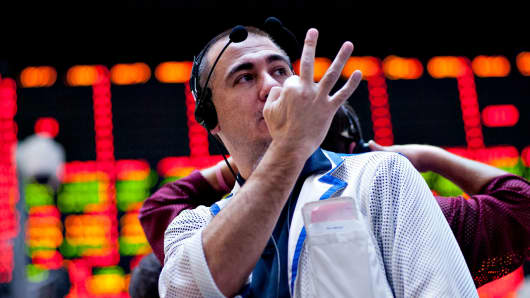Discussions on when the Federal Reserve is likely to reduce its bond buying program have reached fever pitch, with analysts and bond fund managers divided on both the timing and the impact the Fed's "tapering" action could have.
Societe Generale analysts have thrown their hat in the ring with a bold prediction. They expect the Fed to taper quantitative easing (QE) in the autumn of this year and totally end the program at the turn of the year.
According to the bank, 10-year U.S. Treasury bond yields will hit 3 percent by Spring next year and rise to 5 percent by 2017. Such a big move in yields that are used as a benchmark across the world has the potential to roil markets.
Bond prices have fallen sharply in recent weeks, pushing yields higher, with the 10-year yield jumping to 2.2 percent from 1.6 percent in just six weeks.
(Read More: Bond Sell-Off Heightens Risk of '1994 Moment')
"We believe the U.S. treasury yield will be at 3 percent come spring next year and that in itself is quite a big move for the markets to be digesting, so I think a lot more choppiness coming out there for the months ahead," said Michala Marcussen, SocGen's global head of economics.
Marcussen said the bank looked at the conditions needed for a sustainable recovery and boiled it down to 5 main criteria, which were already in place.
Here's the list:
-- Deleveraging for U.S. households and corporates has already taken place
-- Credit conditions have improved significantly
-- Housing supply has tightened with foreclosure stock being unwound, bringing demand and supply into better balance
-- Policy uncertainty, while is hard to measure, has dissipated with the fiscal cliff situation no longer so dire
-- The supply side still has plenty of slack, offering ample capacity for a recovery
However, Ian Spreadbury, strategic bond fund manager at Fidelity, said the turmoil in the markets since Bernanke's "bombshell" on tapering showed how hooked investors were to money printing and that would make it very difficult for the Fed to exit QE.
(Read More: US Government Forced to Pay Positive Real Rates on Debt)
He said Fidelity's base case is QE will continue with benign inflation: "Our treasury model based on that scenario indicates that yields stay low and potentially go even lower," he said.
"On a two-year view, I would put an 80 percent chance of QE continuing and possibly increasing. The chances of QE reducing are in the 20-25 percent range, but clearly that would have an impact on yields. For that to happen I think we need to have a more convincing pick-up in growth."
Spreadbury's alternative scenarios outline the possibility for QE to stop next year, which would send rates to 3 percent, but he said the negative impact on the economy would be so great that such a scenario was not very likely.
Ian Winship, absolute return bond fund manager at BlackRock, said while he thinks yields on the 10-year Treasury will rise, he said the Fed will prevent them rising over 3 percent, as anything over that could "short circuit" the recovery.
"For those that think yields are going a lot higher– that's a big call. If they don't control the yield then that tapers growth more than anything else, and when inflation is barely above 1 percent, that is a real worry for the Fed," said Winship.
"If they go to 3 percent, that is going to increase the mortgage rate and take away one of the pillars that is supporting the U.S. economic revival."
—By CNBC's Jenny Cosgrave: Follow her on Twitter @jenny_cosgrave



